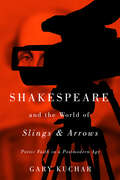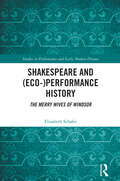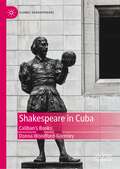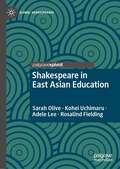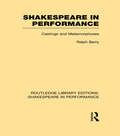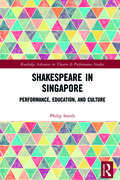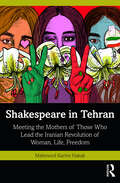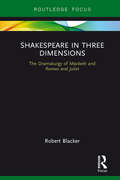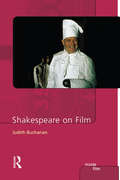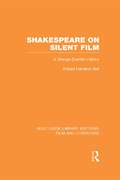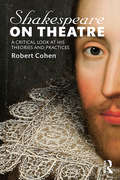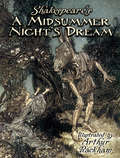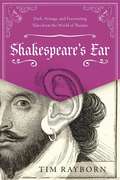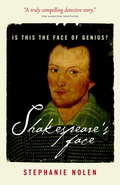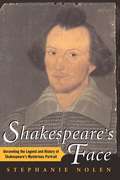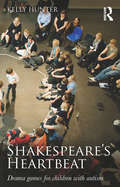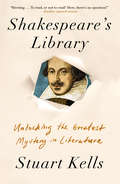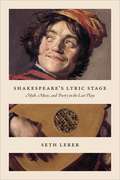- Table View
- List View
Shakespeare and the Visual Imagination
by Stuart SillarsShakespeare's knowledge of the practices of visual art, its fundamental concepts and the surrounding debates is clear from his earliest works. This book explores this relationship, showing how key works develop visual compositions as elements of dramatic movement, construction of ideas, and reflections on the artifice of theatre and language. The Taming of the Shrew, Love's Labour's Lost, Richard II and A Midsummer Night's Dream are explored in detail, offering new insights into their forms, themes, and place in European traditions. The use of emblems is examined in Titus Andronicus and As You Like It; studies of Venus and Adonis, some sonnets and The Rape of Lucrece reveal different but related visual aspects; a later chapter suggests how the new relation between seeing and soliloquy in The Rape of Lucrece is developed in other plays. Extensively illustrated, the book explores Shakespeare's assimilation and exploration of visual traditions in structure, theme and idea throughout the canon.
Shakespeare and the World of “Slings & Arrows”: Poetic Faith in a Postmodern Age
by Gary KucharSlings & Arrows, starring Susan Coyne, Paul Gross, Don McKellar, and Mark McKinney as members of the New Burbage Theatre Festival, was heralded by television critics as one of the best shows ever produced and one of the finest depictions of life in classical theatre. Shakespeare scholars, however, have been ambivalent about the series, at times even hostile.In Shakespeare and the World of “Slings & Arrows” Gary Kuchar situates the three-season series in its cultural and intellectual contexts. More than a roman à clef about Canada’s Stratford Festival, he shows, it is a privileged window onto major debates within Shakespeare studies and a drama that raises vital questions about the role of the arts in society. Kuchar reads the television show – ever fluctuating between faith and doubt in the power of drama – as an allegory of Peter Brook’s widely renowned account of modern theatre, The Empty Space, mirroring Brook’s distinction between holy theatre, a quasi-sacred vocation, and deadly theatre, a momentary entertainment.Combining contextualized interpretations of the series with subtle formalist readings, Kuchar explains how Slings & Arrows participates in a broader recuperation of humanist approaches to Shakespeare in contemporary scholarship. The result is a demonstration of how and why Shakespeare continues to provide not just entertainment, but equipment for living.
Shakespeare and: The Merry Wives of Windsor (ISSN)
by Elizabeth SchaferSeismic shifts in the theatrical meanings of The Merry Wives of Windsor have taken place across the centuries as Shakespeare’s frequently performed play has relocated to Windsor across the world, journeying along the production/adaptation/appropriation continuum.This (eco-)performance history of Shakespeare’s The Merry Wives of Windsor not only offers the first in-depth analysis of the play in production, with a particular focus on the representation of merry women, but also utilises the comedy’s forest-aware dramaturgy to explore Mistress Page’s concept of being ‘frugal in my mirth’ in relation to sustainable theatre practices. Herne’s Oak – the fictitious tree in Windsor Forest where everyone meets in the final scene of the play – is utilised to enable a maverick but ecologically based reframing of the productions of Merry Wives analysed here.This study engages with gender, physical comedy, and cultural relocations of Windsor across the world to offer new insight into Merry Wives and its theatricality.
Shakespeare behind Bars: One Teacher's Story of the Power of Drama in a Women's Prison
by Jean TrounstineIn this deeply stirring account, Jean Trounstine, who spent 10 years teaching at Framingham (MA) Women's Prison, focuses on six inmates who, each in her own way, discover in the power of Shakespeare a way to transcend the painful constraints of incarceration. Shakespeare Behind Bars is a powerful story about the redemptive power of art and education. Originally published in cloth in 2001, the paperback includes a new foreword that will inspire all teachers who work with students others have deemed unteachable. A new afterword updates readers on the prison art's program -- and the author herself -- since 2001.
Shakespeare in Cuba: Caliban’s Books (Global Shakespeares)
by Donna Woodford-GormleyShakespeare in Cuba: Caliban’s Books explores how Shakespeare is consumed and appropriated in Cuba. It contributes to the underrepresented field of Latin American Shakespeares by applying the lens of cultural anthropophagy, a theory with Latin American roots, to explore how Cuban artists ingest and transform Shakespeare’s plays. By consuming these works and incorporating them into Cuban culture and literature, Cuban writers make the plays their own while also nourishing the source texts and giving Shakespeare a new afterlife.
Shakespeare in East Asian Education (Global Shakespeares)
by Adele Lee Rosalind Fielding Sarah Olive Kohei UchimaruThis book offers fresh, critical insights into Shakespeare in Hong Kong, Japan, and Taiwan. It recognises that Shakespeare in East Asian education is not confined to the classroom or lecture hall but occurs on diverse stages. It covers multiple aspects of education: policy, pedagogy, practice, and performance. Beyond researchers in these areas, this book is for those teaching and learning Shakespeare in the region, those teaching and learning English as an Additional Language anywhere in the world, and those making educational policies, resources, or theatre productions with young people in East Asia.
Shakespeare in Malawi: Power and Performance (Global Shakespeares)
by Amy BonsallThis book critically examines the forces and events that led to Shakespeare performance becoming an important part of the contemporary Malawian cultural and educational landscape. It brings together archive material, interviews, existing literature and practice as research to understand, examine and interrogate theories of ‘intercultural theatre’ and post-colonial theories, to highlight the unique practice of Shakespeare production in Malawi. A timeline of Shakespeare productions in Malawi is included, spanning the colonialist period through to the present day. The book explores local adaptations of As You Like It and Macbeth and the translation into Chichewa of Romeo and Juliet, providing a unique insight into the practice and methodologies of Malawian Shakespeare translation, including the role of women as performers and artists. It looks at the current state of drama and theatre in Malawi and what the future of Shakespeare in Malawi might look like.
Shakespeare in Performance: Castings and Metamorphoses (Routledge Library Editions: Shakespeare in Performance)
by Ralph BerryThese studies take stage history as a means of knowing the play. Half of the studies deal with casting - doubling, chorus and the crowd, the star of Hamlet and Measure for Measure. Then the transformations of dramatis personae are analyzed and The Tempest is viewed through the changing relationships of Prospero, Ariel and Caliban. Some of Shakespeare’s most original strategies for audience control are studied, such as Cordelia's asides in King Lear, Richard II’s subversive laughter and the scenic alternation of pleasure and duty in Henry IV. Performance is the realization of identity. The book draws on major productions up to 1992, just before the book was originally published.
Shakespeare in Quebec
by Jennifer DrouinIn Shakespeare in Québec, Jennifer Drouin analyses representations of nation and gender in Shakespearean adaptations written in Québec since the Quiet Revolution. Using postcolonial and gender theory, Drouin traces the evolution of discourses of nation and gender in Québec from the Conquest of New France to the present, and she elaborates a theory of adaptation specific to Shakespeare studies.Drouin's book explains why Québécois playwrights seem so obsessed with rewriting "le grand Will," what changes they make to the Shakespearean text, and how the differences between Shakespeare and the adaptations engage the nationalist, feminist, and queer concerns of Québec society.Close readings from ten plays investigate the radical changes to content that allowed Québécois playwrights to advocate for political change and contribute to the hot debates of the Quiet Revolution, the 1970 October Crisis, the 1980 and 1995 referenda, the rise of feminism, and the emergence of AIDS. Drouin reveals not only how Shakespeare has been adapted in Québec but also how Québécois adaptations have evolved in response to changes in the political climate. As a critical analysis in English of rich but largely ignored French plays, Shakespeare in Québec bridges Canada's "two solitudes."
Shakespeare in Singapore: Performance, Education, and Culture (Routledge Advances in Theatre & Performance Studies)
by Philip SmithShakespeare in Singapore provides the first detailed and sustained study of the role of Shakespeare in Singaporean theatre, education, and culture. This book tracks the role and development of Shakespeare in education from the founding of modern Singapore to the present day, drawing on sources such as government and school records, the entire span of Singapore's newspaper archives, playbills, interviews with educators and theatre professionals, and existing academic sources. By uniting the critical interest in Singaporean theatre with the substantial body of scholarship that concerns global Shakespeare, the author overs a broad, yet in-depth, exploration of the ways in which Singaporean approaches to Shakespeare have been shaped by, and respond to, cultural work going on elsewhere in Asia. A vital read for all students and scholars of Shakespeare, Shakespeare in Singapore offers a unique examination of the cultural impact of Shakespeare, beyond its usual footing in the Western world.
Shakespeare in Singapore: Performance, Education, and Culture (Routledge Advances in Theatre & Performance Studies)
by Philip SmithShakespeare in Singapore provides the first detailed and sustained study of the role of Shakespeare in Singaporean theatre, education, and culture. This book tracks the role and development of Shakespeare in education from the founding of modern Singapore to the present day, drawing on sources such as government and school records, the entire span of Singapore's newspaper archives, playbills, interviews with educators and theatre professionals, and existing academic sources. By uniting the critical interest in Singaporean theatre with the substantial body of scholarship that concerns global Shakespeare, the author overs a broad, yet in-depth, exploration of the ways in which Singaporean approaches to Shakespeare have been shaped by, and respond to, cultural work going on elsewhere in Asia. A vital read for all students and scholars of Shakespeare, Shakespeare in Singapore offers a unique examination of the cultural impact of Shakespeare, beyond its usual footing in the Western world.
Shakespeare in Tehran: Meeting the Mothers of Those Who Lead the Iranian Revolution of Woman, Life, Freedom
by Mahmood Karimi HakakShakespeare in Tehran is a personal history of Iran through the eyes of an award-winning Iranian American artist. Drawing on parallels between life and the stage, it uses A Midsummer Night’s Dream as a roadmap to explore social, political, economic, and cultural aspects of Iran before and after the revolution of 1979. Through first-person accounts, interspersed with emotional reflections of the universal human experience, it delves into the historical and sociological context of a divided country. Storytelling, flashbacks, and flashforwards paint an intimate picture of public life in Iran in a time of uncertainty. Accessible, engaging, and nuanced, this volume will be of interest to scholars and researchers of politics, history, theater and performance studies, and West Asian studies.
Shakespeare in Three Dimensions: The Dramaturgy of Macbeth and Romeo and Juliet (Focus on Dramaturgy)
by Robert BlackerIn Shakespeare in Three Dimensions, Robert Blacker asks us to set aside what we think we know about Shakespeare and rediscover his plays on the page, and as Shakespeare intended, in the rehearsal room and in performance. That process includes stripping away false traditions that have obscured his observations about people and social institutions that are still vital to our lives today. This book explores the verities of power and love in Romeo and Juliet and Macbeth, as an example of how to mine the extraordinary detail in all of Shakespeare’s plays, using the knowledge of both theatre practitioners and scholars to excavate and restore them.
Shakespeare on Film
by Judith R. BuchananFrom the earliest days of the cinema to the present, Shakespeare has offered a tempting bank of source material than the film industry has been happy to plunder. Shakespeare on Film deftly examines an extensive range of films that have emerged from the curious union of an iconic dramatist with a medium of mass appeal. The many films Buchanan studies are shown to be telling indicators of trends in Shakespearean performance interpretation, illuminating markers of developments in the film industry and culturally revealing about broader influences in the world beyond the movie theatre. As with other titles from the Inside Film series, the book is illustrated throughout with stills. Each chapter concludes with a list of suggested further reading in the field.
Shakespeare on Screen Othello
by Hatchuel, Sarah and Vienne-Guerrin, Nathalie Sarah Hatchuel Nathalie Vienne-Guerrin"The first volume in the re-launched series Shakespeare on Screen is devoted to Othello, offering up-to-date coverage of recent screen versions as well as new critical essays on older, canonical films. An international cast of authors explores not only productions from the USA and UK, but also translations, adaptations and appropriations in Québec, Italy, India, Brazil and Mexico. The volume takes part in the ceaseless cultural investigation of what Othello says about Shakespeare, the past and our present time, supported by an invaluable film-bibliography. Accompanying free online resources include a fuller version of the bibliography and an additional contribution on YouTube versions of Othello. This book will be a valuable resource for students, scholars and teachers of film studies and Shakespeare studies"--
Shakespeare on Silent Film: A Strange Eventful History (Routledge Library Editions: Film and Literature)
by Robert Hamilton BallIn 1899, when film projection was barely three years old, Herbert Beerbohm Tree was filmed as King John. In his highly entertaining history, Robert Hamilton Ball traces in detail the fate of Shakespeare on silent films from Tree’s first effort until the establishment of sound in 1929. The silent films brought Shakespeare to a wide public who had never had the chance to see his plays in the theatre. And Shakespeare gave the film makers an air of respectability that was badly needed by a medium with a reputation for frivolity. This work, first published in 1968, brings history to life with excerpts from scenarios, from reviews and from contemporary film journals, and with reproduction of stills and frames from the films themselves, including unusual shots of leading screen actors. This is a valuable source book for film experts, enhanced by full notes, bibliography and indexes; a fresh approach for Shakespeareans; and a vivid sketch of a world that has passed for all.
Shakespeare on Theatre: A Critical Look at His Theories and Practices
by Robert CohenIn Shakespeare on Theatre, master acting teacher Robert Cohen brilliantly scrutinises Shakespeare's implicit theories of acting, paying close attention to the plays themselves and providing a wealth of fascinating historical evidence. What he finds will surprise scholars and actors alike – that Shakespeare's drama and his practice as an actor were founded on realism, though one clearly distinct from the realism later found in Stanislavski. Shakespeare on Acting is an extraordinary introduction to the way the plays articulate a profound understanding of performance and reflect the life and times of a uniquely talented theatre-maker.
Shakespeare on the University Stage
by Andrew James HartleyFeaturing essays from seventeen international scholars, this exciting new collection is the first sustained study of Shakespeare on the university and college stage. Treating the subject both historically and globally, the essays describe theatrical conditions that fit neither the professional nor the amateur models and show how student performances provide valuable vehicles for artistic construction and intellectual analysis. The book redresses the neglect of this distinctive form of Shakespeare performance, opening up new ways of thinking about the nature and value of university production and its ability to draw unique audiences. Looking at productions across the world - from Asia to Europe and North America - it will interest scholars as well as upper-level students in areas such as Shakespeare studies, performance studies and theatre history.
Shakespeare's A Midsummer Night's Dream
by William Shakespeare Arthur RackhamShakespeare's incomparable romantic comedy takes on a new and vivid life in these brilliant images by one of the 20th century's leading illustrators. The fairy world of A Midsummer Night's Dream is the perfect milieu for the artistry of Arthur Rackham, a popular illustrator of fairy tales who possessed a striking gift for depicting fanciful creatures. His dreamlike visions provide a series of unique portraits from the enchanted wood outside ancient Athena, where Oberon and Titania rule a kingdom of diminutive sprites. <p><p> Rackham's career coincided with the era known as the Golden Age of Illustration, an age that witnessed the rise of increasingly sophisticated color printing techniques. His interpretation of A Midsummer Night's Dream, which first appeared in 1908, received the full benefit of the improved technology, and this faithful reprint offers a quality of printing and sharpness of reproduction that rivals the limited and first editions. The complete text of the play appears here, along with 40 full-color and numerous black-and-white illustrations — a splendid tribute by a master of fantasy art to an immortal play.
Shakespeare's Ear: Dark, Strange, and Fascinating Tales from the World of Theater
by Tim RaybornShakespeare’s Ear presents dark and sometimes funny pieces of fact and folklore that bedevil the mostly unknown history of theater. All manner of skullduggery, from revenge to murder, from affairs to persecution, proves that the drama off-stage was just as intense as any portrayed on it. The stories include those of: An ancient Greek writer of tragedies who dies when an eagle drops a tortoise on his head. A sixteenth-century English playwright who lives a double life as a spy and perishes horribly, stabbed above the eye. A small Parisian theater where grisly horrors unfold on stage. The gold earring that Shakespeare wears in the Chandos portrait, and its connections to bohemians and pirates of the time. Journey back to see theatrical shenanigans from the ancient Near East, explore the violent plays of ancient Greece and Rome, revel in the Elizabethan and Jacobean golden age of blood-thirsty drama, delight in the zany and subversive antics of the Commedia dell’arte, and tremble at ghostly incursions into playhouses. Here you will find many fine examples of playwrights, actors, and audiences alike being horrible to each other over the centuries.
Shakespeare's Face
by Stephanie NolenOn May 11, 2001, Globe and Mail reporter Stephanie Nolen announced a stunning discovery to the world: an attractive portrait held by an Ontario family for twelve generations, which may well be the only known portrait of Shakespeare painted during his lifetime. Shakespeare's Face is the biography of a portrait -- a literary mystery story -- and the furious debate that has ensued since its discovery.A slip of paper affixed to the back proclaims "Shakespere. This likeness taken 1603, Age at that time 39 ys." But is it really Shakespeare who peers at us from the small oil on wood painting? The twinkling eyes, reddish hair, and green jacket are not in keeping with the duller, traditional images of the bard. But they are more suggestive of the humorous and humane man who wrote the greatest plays in the English language.Shakespeare's Face tells the riveting story of how the painting came to reside in the home of a retired engineer in a mid-sized Ontario town. The painting is reputed to be by John Sanders of Worcester, England. As a retirement project, the engineer, whose grandmother kept the family treasure under her bed, embarked on authenticating the portrait: the forensic analyses that followed have proven it without doubt to the period.In a remarkable publishing coup, Knopf Canada has gathered around Stephanie Nolen's story a group of the world's leading Shakespeare scholars and art and cultural historians to delve into one of the most fascinating literary mysteries of our times: "Is this the face of genius?"Excerpt from Chapter 1 of Shakespeare's Face by Stephanie NolenBy the late afternoon I was beginning to go a little cross-eyed. I had examined countless documents and read the test results from the painting's painstaking forensic analysis. I now had everything I needed to write my story -- except for one crucial item. "Is he here?" I asked, almost in a whisper....The owner laid the package carefully on the cluttered table. He gently pulled back the kraft paper wrapping, underneath which was a layer of bubble wrap. Then he peeled back this second layer to reveal his treasure.I was caught off-guard by how small the portrait was -- and how vivid. The colours in the paint seemed too rich to be 400 years old. Except for the hairline cracks in the varnish, the face could have been painted yesterday. And there was nothing austere or haughty about it, nothing of the great man being painted for posterity. It was a rogue's face, a charmer's face that looked back at me with a tolerant, mischievous slightly world-weary air....It was painted on two pieces of solid board so expertly joined that the seam was barely visible. A date, "Ano 1603", was painted in small red letters in the top right hand corner. The right side had been nibbled by woodworms.... I stood and gazed, quelling an instinctive urge to pick the portrait up and hold it in my hands. And as my professional skepticism crumpled for a moment, I found myself wanting desperately to believe that this was indeed Shakespeare's face.
Shakespeare's Face: Unraveling the Legend and History of Shakespeare's Mysterious Portrait
by Stephanie NolenA fascinating literary detective story charting the surprising, true history of a recently discovered painting of Shakespeare held by the same family for 400 years -- adding new drama to the Bard's life.When author Stephanie Nolen reported the discovery of the only portrait of William Shakespeare painted while he was alive, the announcement ignited furious controversy around the world.Now, in this provocative biography of the portrait, she tells the riveting story of how a rare image of the young Bard at thirty-nine came to reside in the suburban home of a retired engineer, whose grandmother kept the family treasure under her bed, and how he embarked on authenticating it. The ultimate Antiques Roadshow dream, the portrait has been confirmed by six years of painstaking forensic studies to date from around 1600, and it has not been altered since.
Shakespeare's Heartbeat: Drama games for children with autism
by Kelly HunterChildren on the autistic spectrum experience varying degrees of difficulties; all of which can be understood as a disassociation of mind and body. Expressing feelings, making eye contact, keeping a steady heartbeat and recognizing faces are all part of the autism dilemma which can be poetically explored by Shakespeare. Over ten years, Hunter worked with children on all points of the spectrum, developing drama games for the specific purpose of combatting autism. These unique games, derived from specific moments in the plays, shed new light on how to teach Shakespeare to children, using the drama as an exploration of how it feels to be alive. Shakespeare’s Heartbeat is a step-by-step guide, detailing how to demonstrate, play and share these sensory games. The book includes: Games based on A Midsummer Night’s Dream Games based on The Tempest Tips and advice for playing one-on-one with the children An afterword describing Hunter’s journey from performer and practitioner to creator of this work. Shakespeare’s poetic definitions of seeing, thinking and loving reveal the very processes that children with autism find so difficult to achieve. This book provides an indispensable learning tool for those wishing to encourage children’s eye contact and facial expression, improve their spatial awareness and language skills and introduce them to imaginative play.
Shakespeare's Library: Unlocking the Greatest Mystery in Literature
by Stuart KellsA tantalizing true story of one of literature’s most enduring enigmas is at the heart of this “lively, even sprightly book” (Michael Dirda, The Washington Post)—the quest to find the personal library of the world’s greatest writer.Millions of words of scholarship have been expended on the world’s most famous author and his work. And yet a critical part of the puzzle, Shakespeare’s library, is a mystery. For four centuries people have searched for it: in mansions, palaces and libraries; in riverbeds, sheep pens and partridge coops; and in the corridors of the mind. Yet no trace of the bard’s manuscripts, books or letters has ever been found.The search for Shakespeare’s library is much more than a treasure hunt. Knowing what the Bard read informs our reading of his work, and it offers insight into the mythos of Shakespeare and the debate around authorship. The library’s fate has profound implications for literature, for national and cultural identity, and for the global Shakespeare industry. It bears on fundamental principles of art, identity, history, meaning and truth.Unfolding the search like the mystery story that it is, acclaimed author Stuart Kells follows the trail of the hunters, taking us through different conceptions of the library and of the man himself. Entertaining and enlightening, Shakespeare’s Library is a captivating exploration of one of literature’s most enduring enigmas."An engaging and provocative contribution to the unending world of Shakespeariana . . . An enchanting work that bibliophiles will savor and Shakespeare fans adore." ―Kirkus Reviews
Shakespeare's Lyric Stage: Myth, Music, and Poetry in the Last Plays
by Seth LererWhat does it mean to have an emotional response to poetry and music? And, just as important but considered less often, what does it mean not to have such a response? What happens when lyric utterances—which should invite consolation, revelation, and connection—somehow fall short of the listener’s expectations? As Seth Lerer shows in this pioneering book, Shakespeare’s late plays invite us to contemplate that very question, offering up lyric as a displaced and sometimes desperate antidote to situations of duress or powerlessness. Lerer argues that the theme of lyric misalignment running throughout The Tempest, The Winter’s Tale, Henry VIII, and Cymbeline serves a political purpose, a last-ditch effort at transformation for characters and audiences who had lived through witch-hunting, plague, regime change, political conspiracies, and public executions. A deep dive into the relationship between aesthetics and politics, this book also explores what Shakespearean lyric is able to recuperate for these “victims of history” by virtue of its disjointed utterances. To this end, Lerer establishes the concept of mythic lyricism: an estranging use of songs and poetry that functions to recreate the past as present, to empower the mythic dead, and to restore a bit of magic to the commonplaces and commodities of Jacobean England. Reading against the devotion to form and prosody common in Shakespeare scholarship, Lerer’s account of lyric utterance’s vexed role in his late works offers new ways to understand generational distance and cultural change throughout the playwright’s oeuvre.

